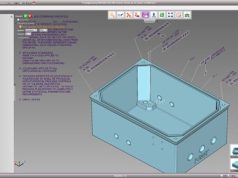3DPrinterOS offers a comprehensive solution for the centralised management of 3D printers and related workflows. This cloud-based platform enables companies, educational institutions, and individuals to efficiently utilise and optimise their 3D printing resources. In an interview with 3Druck.com, VP of Global Sales Rene-Oscar Ariko shares his insights into the key benefits of 3D printer management software.
3DPrinterOS was founded in 2014 with the mission to revolutionize the 3D printing landscape through a cloud-based platform that simplifies the management and operation of 3D printers. The platform offers a comprehensive suite of tools for managing, monitoring, and optimising 3D printing workflows, making it easier for users to collaborate and innovate. Key features include real-time analytics, remote printing capabilities, automated job scheduling, and extensive compatibility with a wide range of 3D printers.
By centralising the 3D printing process, 3DPrinterOS aims to enhance efficiency, reduce costs, and democratise access to additive manufacturing technology.
Interview with Rene-Oscar Ariko
In an interview with 3Druck.com, Rene-Oscar Ariko, Vice President of Global Sales, outlines the key benefits of 3D printer management software for the industry. He also shares what he considers to be some of the most important innovations in the software field and comments on the impact of crisis and possible future developments in the AM sector.
In your opinion, what are the main benefits of management software in the additive manufacturing industry?
In the additive manufacturing industry, management software provides several critical benefits. One significant advantage is efficiency and productivity. The software streamlines the entire printing process from design to finished product, reducing the time and effort required to manage each stage. This leads to a smoother workflow and faster production times.
Another key benefit is cost reduction. By optimising workflows and reducing material waste, companies can significantly lower their operational costs. This financial efficiency is crucial for maintaining competitive pricing and improving profit margins.
Scalability is also a major advantage offered by management software. Cloud-based solutions allow businesses to scale their operations easily, managing multiple printers and locations from a single interface. This flexibility supports business growth and the ability to handle larger projects without proportional increases in management complexity.
Collaboration is enhanced through remote access and shared platforms, which facilitate teamwork across different teams and geographical locations. This capability promotes innovation and increases overall productivity by enabling seamless cooperation.
Lastly, data management and security are improved with secure cloud storage, ensuring that all data is protected and easily accessible. Detailed logs and analytics provided by the software help track performance and identify areas for improvement, contributing to better decision-making and operational efficiency.
Additive manufacturing has developed continuously over the last few years. What innovations or technological breakthroughs do you consider most important when it comes to 3D printer management software?
Recent innovations in 3D printer management software that have made a significant impact include integrating AI and machine learning. This integration allows for predictive maintenance and print optimisation, which helps in reducing downtime and improving print quality. Additionally, the Internet of Things (IoT) enables real-time monitoring and control of printers, leading to smarter, more responsive manufacturing environments.
Enhanced security features, such as advanced encryption and secure data transfer protocols, protect intellectual property and sensitive information. Automated workflow management is another critical innovation, where automated job scheduling and resource allocation ensure optimal use of time and materials.
Moreover, advanced analytics provide detailed insights into printer performance, material usage, and overall efficiency. These insights allow for continuous improvement, making the manufacturing process more efficient and effective.
First Corona and now high inflation are major challenges for the whole industry. How do you think the multiple crises will affect the additive manufacturing industry?
The additive manufacturing industry, like many others, has faced challenges due to the COVID-19 pandemic and high inflation. However, these crises have also underscored the value of flexible, decentralised manufacturing capabilities that 3D printing offers. One key impact is supply chain resilience. 3D printing can mitigate supply chain disruptions by enabling on-demand production closer to the point of use.
Additionally, cost pressures from high inflation drive the need for cost-efficient production methods, making the resource-saving aspects of additive manufacturing more attractive. Furthermore, the pandemic has accelerated the adoption of digital and automated solutions, pushing companies to innovate faster and integrate advanced technologies into their workflows.
What impact do you think additive manufacturing will have on different industries and possibly society as a whole in the coming years?
Additive manufacturing is poised to have transformative effects across various industries and society as a whole. In the coming years, it is expected to revolutionise healthcare by enabling the creation of customisable prosthetics, implants, and even bioprinted organs, which could significantly improve patient care. In the automotive and aerospace sectors, the production of lightweight and durable components through 3D printing can enhance fuel efficiency and performance.
In the realm of consumer goods, customisation and on-demand production will become more prevalent, offering consumers unique and personalised products. Additionally, additive manufacturing’s ability to reduce waste and utilise sustainable materials will support environmental goals, contributing to greater sustainability.
Furthermore, the increased access to 3D printing technology in education will spur innovation and creativity, driving new discoveries and advancements. Overall, the integration of 3D printing into mainstream manufacturing processes will continue to reshape industries, making production more efficient, sustainable, and responsive to market needs.
Here you can find more information on 3DPrinterOS.
Subscribe to our Newsletter
3DPresso is a weekly newsletter that links to the most exciting global stories from the 3D printing and additive manufacturing industry.






















